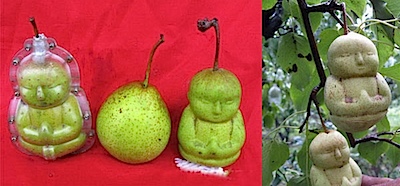- India tree planter tells BBC his story. But what species?
- Photoessay on Irish farm, begorrah!
- The next rubber boom?
- A “modern-day Johnny Appleseed for ash trees.”
- Qur’anic Botanical Garden established in Qatar.
- Egyptians regret pig cull.
Nibbles: IUCN book, Ancient DNA, Durian, Bees, Enola
- IUCN book Conservation for a New Era is out. Agriculture on page 160.
- Ancient DNA, from the general to the particular, courtesy of pigs.
- Durian and alcohol don’t mix. Damn.
- New Internationalist does a number on bees. Thanks, Lubin.
- The last word on the Enola bean case. At last.
Nibbles: Banana disease, Prickly pears, Pea breeding, Aquaculture, Bees, Soil microbes
- A letter makes some very important points about bananas in Africa. There’s a huge back-story to this, but we’re not going to go there.
- Prickly pear fruit chips. An opportunity beckons, for someone.
- Building the perfect pea.
- Half of fish farmed. But which half?
- Scientific American bee podcast.
- “…there is a whole world of microbes underground, associated with the roots of plants, that has yet to be analyzed.”
Nibbles: Chickens, Peppers, Treaty, Breadfruit, Preservation, Food systems, Adaptation, Yam multiplication
- Naked necked chicken in music video shock.
- Piment d’Espalette. Jeremy asks “What’s the big deal, really?”
- The ITPGRFA on CNN.
- Fiji to set up breadfruit genebank.
- Lacto-fermenting your eggplant and chrysanthemum petals.
- More on FAO’s Indigenous Peoples’ Food Systems book.
- “Where farming communities have been able to maintain their traditional varieties, they are already using them to cope with the impacts of climate change.”
- Yam Minisett Technology pushed.
(New) things to do with pears
A little something silly for the weekend.
This bizarre story made it to Boing Boing and the Daily Mail, but the earliest I can find for it, and indeed where I first saw it (Thanks, Matt), was a website in Portuguese. Now, through the miracle of Google Translate, we bring you, How to make pear shaped Buddha!
I think this is the “How to” Strange as I posted here, after all, who is going to try this at home? Well, then, for purposes of curiosity, if you ever heard of pear-shaped Buddha or even the famous square watermelons in Japan knows that the process is simple, just put a cast on fruit when they are starting to rise because the fruit tends to take the shape of the mold as it unfolds.
I’m afraid of what marketers can do with it …
I’m more afraid of what the Mail did to it, but no matter. More to the point, even the square watermelon is not as new as all that. From Popular Science, January 1938:
Farmer Grows Pumpkins with Human Faces
Pumpkins with human faces have been produced by John M. Czeski, Ohio farmer, after four years of experimenting. To grow the novel fruit, Czeski fashions an aluminum mold of the head he wants to reproduce, and places it around a growing pumpkin approximately the size of a small grapefruit. After the pumpkin has expanded enough to fill the inside contours, the mold is removed. The print of the features remains as the pumpkin continues to grow, and the final result is a lifelike full-size image in the ripened fruit.
Nothing new etc.

